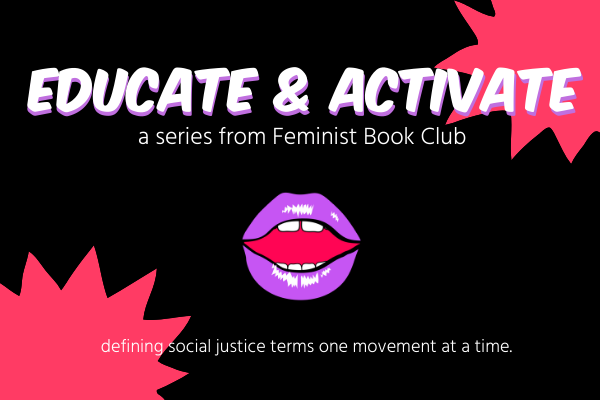Feminist Book Club blog contributors are working together to create posts as an “Educate & Activate” series. We will define a term or movement, provide historical context, and give you additional resources to learn more. We believe that an educated populace can be better activists, accomplices and co-conspirators. It is important to note that these are meant to be brief descriptions and not inclusive or exhaustive of all resources. We urge you to continue being curious, and continue learning more.
Feeling lost? Read about First Wave Feminism & Second Wave Feminism
Definition:
What is Third-Wave Feminism? It began with the Anita Hill case in 1991 which brought sexual harassment at work to the fore. Third-wave “feminists sought to question, reclaim, and redefine the ideas, words, and media that have transmitted ideas about womanhood, gender, beauty, sexuality, femininity, and masculinity, among other things.”
First usage
A New York Times article by Martha Weinman Lear, “The Second Feminist Wave” first used the wave metaphor. Since then, the different waves of feminism are used to denote the different periods of feminism.
Historical context
Third-wave feminism was a backlash against contemporary politics, economic policies, and the anti-feminism of Ronald Reagan’s Presidency of the 1980s. Reagan was anti-abortion; he opposed the Equal Rights Amendment that aimed at gender equality, and he supported the traditional gender roles of women. He was extremely clueless about the wishes and demands of women and which was partly because of his alliance with Christian conservative groups. It was also a reaction to Regan’s neoliberalist policies.
Third-wave feminists were “Influenced by the postmodernist movement in the academy” and “sought to question, reclaim, and redefine the ideas, words, and media that have transmitted ideas about womanhood, gender, beauty, sexuality, femininity, and masculinity, among other things.” Unfortunately, third-wave feminism is often conflated with postfeminism, “a term used to describe a societal perception that many or all of the goals of feminism have already been achieved, thereby making further iterations and expansions of the movement obsolete.” This is not the case as there are still many goals to be achieved, be it in the US or the world.
A major part of third-wave feminism occurred in early online spaces, blogs, and zines influenced by different subcultures. Blogs helped to disseminate content to a wide audience, making the content democratic and available. For instance, Riot Grrrl started as an underground punk music movement in 1991, in Olympia, Washington, when members of Bikini Kill, Bratmobile , and other local all-female and female-fronted bands performed at the event, “Love Rock Revolution Girl Style Now,” shortened to “Girls Night.” Combining feminism, politics, and punk music, Riot Grrrl expanded to 26 countries. The women of Riot Grrrl wanted “to start a ‘girl riot’ against a society they felt offered no validation of women’s experiences” and believed in “girls actively engaging in cultural production, creating their own music and fanzines rather than following existing materials.”
Central to the Riot Grrrl Movement and third-wave feminism, was the production of zines, which are “a noncommercial often homemade or online publication usually devoted to specialized and often unconventional subject matter.” In third-wave feminism, zines “have been used to express opinions on numerous topics and are directed to politically charged females” and “often filled with quotes from famous feminists but offered a personal side to the movement as well.” Riot Grrrl had numerous zines across the world that discussed feminist ideas and were popular as they were revolutionary, easy to produce, and could be easily distributed. Some of the zines can be found here.
As media was the main space where third-wave feminism took place and was circulated, magazines like Bitch and Bust were also important. Lisa Jervis, Benjamin Shaykin, and Andi Zeisler launched “Bitch: Feminist Response to Pop Culture” in 1996. Bitch is an independent, quarterly magazine based out of Portland, Oregon and looks at contemporary pop culture through a feminist lens. On the other hand, Bust is a women’s lifestyle magazine published every two months, covering news, music, sex, art, crafts, and fashion from an independent feminist perspective. Bust is a magazine that women feel good about reading.
Another issue that third-wave feminism was interested in was the representation of women in media, especially with the documentary Jean Kilbourne’s Killing Us Softly (1979) that draws attention on gender representation in advertisements. The other important documentary about representation is Jennifer Siebel Newsom’s Miss Representation (2011) which focused on how mainstream media and culture contribute to the under representation of women in power.
In conclusion, although this is been debated, it is wise to note that feminism is no longer in the third wave but intersectionality has become the fourth wave. Despite some efforts in the second and third waves of feminism, the focus on intersectionality had made feminism more global and accessible. The fourth-wave feminism gained attention through the Women’s March in Washington in January 2017 after the election of Donald Trump; the #MeToo movement that focused on victims of sexual abuse and harassment; and a focus on including women of different races, minorities, sexualities, and abilities.
Resources for Further Education:
Borderlands/La Frontera by Gloria Anzaldúa
Manifesta by Jennifer Baumgardner and Amy Richards
Gender Trouble by Judith Butler
The Riot Grrrl Collection edited by Lisa Darms
The Vagina Monologues by Eve Ensler
Backlash: The Undeclared War Against American Women by Susan Faludi
Bad Feminist by Roxane Gay
Colonize This!: Young Women of Color on Today’s Feminism edited by Daisy Hernandez and Bushra Rehman
Girls to the Front: The True Story of the Riot Grrrl Revolution by Sara Marcus
#MeToo: Essays About How and Why This Happened, What It Means and How to Make Sure It Never Happens Again edited by Lori Perkins
The Beauty Myth by Naomi Wolf
Podcast episode on the history of Riot Grrrls:
Podcast episode featuring Kathleen Hanna, founder of Bikini Kil
Riot Grrrls Playlist
Article on Riot Grrrls





